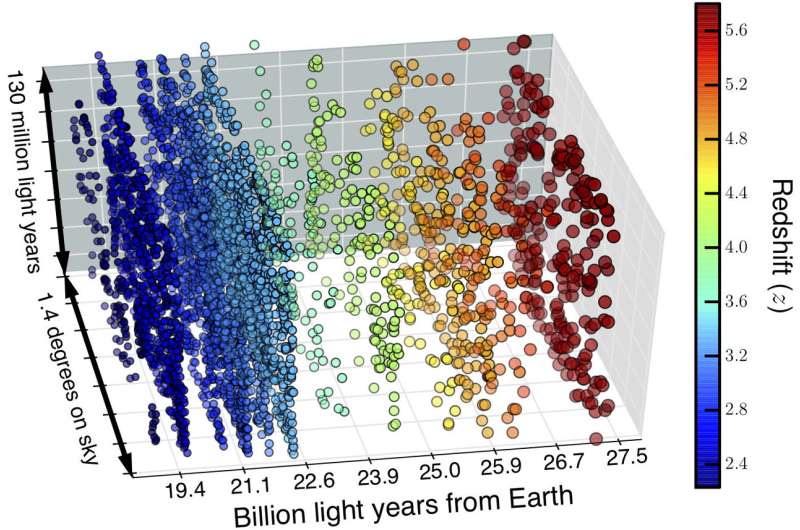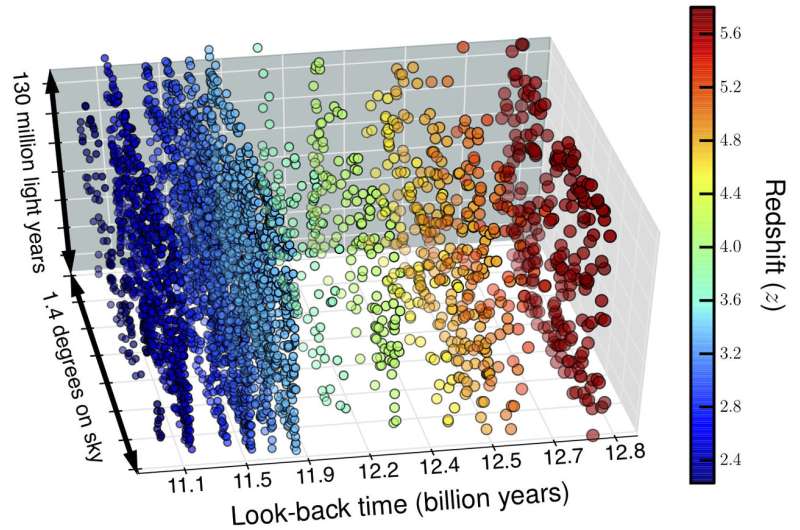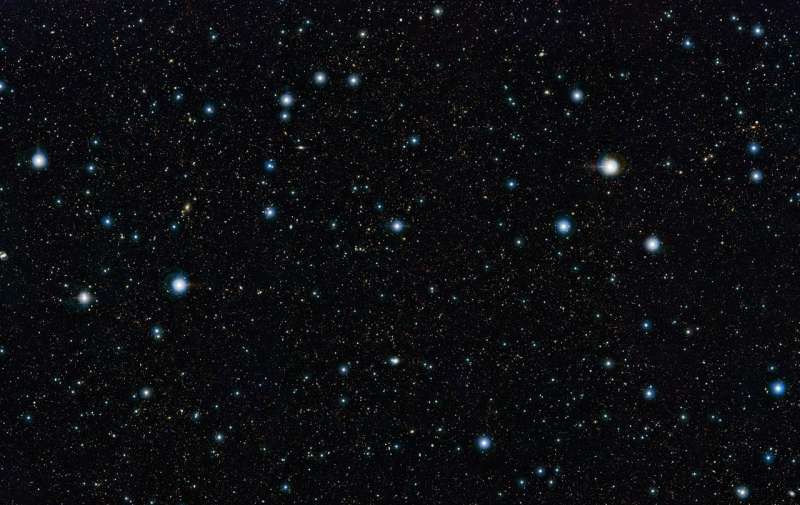Astrophysicists map the infant universe in 3-D and discover 4,000 early galaxies

Astronomers today announce one of the largest 3D maps of the infant Universe, in a presentation at the European Week of Astronomy and Space Science in Liverpool. A team led by Dr David Sobral of Lancaster University made the chart using the Subaru telescope in Hawaii and the Isaac Newton telescope in the Canary Islands. Looking back in time to 16 different epochs between 11 and 13 billion years ago, the researchers discovered almost 4000 early galaxies, many of which will have evolved into galaxies like our own Milky Way.
Light from the most distant galaxies takes billions of years to reach us. This means that telescopes act as time machines, allowing astronomers to see galaxies in the distant past. The light from these galaxies is also stretched by the expansion of the Universe, increasing its wavelength to make it redder. This so-called redshift is related to the distance of the galaxy. By measuring the redshift of a galaxy, astronomers can thus deduce its distance, how long its light has taken to reach us and hence how far back in time we are seeing it.
In the new work the team used filters to sample particular wavelengths of light, and hence specific epochs in the history of the Universe.
Sergio Santos, a Lancaster PhD student and team member, comments: "We used large amounts of data taken with 16 special filters on wide field cameras and processed them here in Lancaster to literally slice the Universe in cosmic time and time-travel to the distant past with 16 well defined cosmic time destinations."
Dr Sobral adds: "These early galaxies seem to have gone through many more "bursts" when they formed stars, instead of forming them at a relatively steady rate like our own galaxy. Additionally, they seem to have a population of young stars that is hotter, bluer and more metal-poor than those we see today."

Sobral and his team found galaxies that existed when the Universe was only 20 to 7% of its current age, and hence provide crucial information about the early phases of galaxy formation.
The researchers also found that these early galaxies are incredibly compact. "The bulk of the distant galaxies we found are only about 3 thousand light years across in size, while our Milky Way is about 30 times larger. Their compactness likely explains many of their exciting physical properties that were common in the early Universe", comments Ana Paulino-Afonso, a PhD student in Lancaster and Lisbon. "Some of these galaxies should have evolved to become like our own and thus we are seeing what our galaxy may have looked like 11 to 13 billion years ago."

The team searched for distant galaxies emitting Lyman-alpha radiation, using 16 different narrow and medium band filters over the COSMOS field, which is one of the most widely studied regions of sky outside our Milky Way, located in the direction of the constellation of Sextans. The Lancaster-led team includes young researchers from Leiden, Lisbon and California. The team also publish their findings in two papers in the journal Monthly Notices of the Royal Astronomical Society and the data are now publicly available for other astronomers to make further discoveries.
More information: "Slicing COSMOS with SC4K: the evolution of typical Lyα emitters and the Lyα escape fraction from z~2to z~6", David Sobral, Sérgio Santos, Jorryt Matthee, Ana Paulino-Afonso, Bruno Ribeiro, João Calhau, Ali Khostovan, Monthly Notices of the Royal Astronomical Society, in press.
"On the UV compactness and morphologies of typical Lyman-α emitters from z ? 2 to z ? 6", Ana Paulino-Afonso, David Sobral, Bruno Ribeiro, Jorryt Matthee, Sérgio Santos, João Calhau, Alex Forshaw, Andrea Johnson, Joanna Merrick, Sara Pérez and Oliver Sheldon, Monthly Notices of the Royal Astronomical Society, in press.
Journal information: Monthly Notices of the Royal Astronomical Society
Provided by Royal Astronomical Society




















